Today marks one of those funky occasions when you’ve probably been aware of the “new” product we’re going to show you for quite some time. And we’re not talking about a few days or weeks here either. In fact, it was all the way back in December of 2011, when AMD introduced the original Radeon HD 7970, that we first dropped hints that the dual-GPU powered Radeon HD 7990 was in the works. We dropped those hints back then because AMD dropped them on us in the lead-up to the Radeon HD 7970’s release. That little tidbit alone should give you a good idea as to how long the Radeon HD 7990 has been simmering in AMD’s kitchen.
Though the product has obviously been in development for quite some time, the Radeon HD 7990 is still an exciting proposition. Despite the relative age of its GPUs, the 7990 still has the potential to be the fastest graphics card to hit the market. NVIDIA’s been firing on all cylinders with its GeForce GTX 600 series products, but AMD has steadily wrung out additional performance from its products through updated drivers and refreshed products clocked slightly higher than their predecessors. Case in point, the Radeon HD 7970 GHz Edition and the Radeon HD 7950 with Boost, among others. AMD has also enticed consumers with its “Never Settle” bundles, which has included many of the hottest games released in recent memory.
Whatever strategery was involved that resulted in a later-than-expected launch of AMD’s dual-GPU powered Radeon HD 7990, it’s here now and we’ve got one. Its specifications are listed below and we’ve got the rest of the scoop on the pages ahead. Strap yourself in and prepare to check out AMD’s most ambitious graphics card release to date...
The AMD Radeon HD 7990: Three Fans, Two GPUs, and a Massive Heatsink
|

The Radeon HD 7990’s specifications seem very impressive upon initial inspection. It sports double the number of transistors, stream processors, texture units, ROPs, and memory as AMD’s previous flagship Radeon HD 7970. But that’s because the Radeon HD 7990 is outfitted with two of the same GPUs and the same 3GB of frame buffer memory for each. There’s a lot more to the card that just its specifications though, as we’ll show you a little later.
Before we dig into the specifics of the new Radeon HD 7990, we’d like to direct you attention to a few past articles that will help lay the foundation for what we’ll be showing you on the pages ahead. Since the pair of Tahiti GPUs at the heart of the Radeon HD 7990 are identical to ones use on AMD’s previously-released, high-end Radeon HD 7900 series products, we’ve covered many of the GPU's key features at length already. As such, we won’t be diving in to them again here.
In our coverage of the original Radeon HD 7970 GHz Edition, we discuss AMD's PowerTune Technology with Boost. In the original Radeon HD 7970 launch, we detail all of the key features of AMD’s Graphics Core Next (GCN) architecture and discuss features like PowerTune and AMD ZeroCore Power technology, GCN Tessellation, Partially Resident Textures (PRT), and Discrete Digital Multi-Point audio, among many others. In our Radeon HD 7950 coverage, we’ve got CrossFireX scores with the 7900-series and in the Radeon HD 7770 and 7750 launch piece, we detail AMD’s latest mainstream DX11 offerings and discuss how GCN was scaled down to cater to different market segments.
A quick glance at the Radeon HD 7990 reveals that this is no run-of-the-mill graphics card. Not only is the Radeon HD 7990 a beast at a full 12” in length, but it sports a newly-designed shroud, three huge cooling fans, and massive heatsink assembly with a dense array of aluminum fins.
Although it looks like there’s only one, gigantic heatsink underneath that fan shroud, there are actually two—one for each GPU. The dual heatsinks each have a copper base, linked to the aluminum thin fins via four copper heatpipes. The three axial fans on the card blow air down onto the heatsinks, where some air is expelled from the case through a vent in the font, but a majority is circulated back into the case. In fact, air is actually expelled from the card in every direction. We should mention that in addition to high-performance, the cooler on the Radeon HD 7990 is designed to be quiet as well—much quieter than previous Radeon HD 7900 series products. But we’ll touch more on that subject later.
The Radeon HD 7990 needs such a large cooling assembly because it is essentially a pair of Radeon HD 7970 GHz Editions crammed onto a single PCB, with just slightly lower GPU clocks. The two Tahiti GPUs powering the card have a peak boost clock of 1GHz (the Radeon HD 7970 GHz Edition boosts to 1050MHz) and they’re each paired to 3GBs of GDDR5 memory clocked at 1.5GHz (6 Gbps, effective), via a 256-bit memory bus, for a total of 6GB of on-board memory. The aggregate effect of having the two GPUs results in a grand total of 4096 stream processors, 256 texture units, 64 ROPs, and a combined 8.6B transistors. Compute performance peaks at 8.2 TFLOPS, with a 256 GT/s textured fillrate and a massive 576 GB/s of memory bandwidth.
The two GPUs on the card are linked together via a 48-lane PCI Express Gen 3 PLX bridge chip that offers 96GB/s of inter-GPU bandwidth.
In addition to the newly-designed cooling hardware, the Radeon HD 7990 is outfitted with a heatplate on the backside of the PCB, which also adds rigidity and the card sports an all-digital PWM. Like AMD's previous dual-GPU flagship, the Radeon HD 6990, the Radeon HD 7990 requires a pair of supplemental 8-pin PCI Express power feeds. Take all of the goodies on a Radeon HD 7970, double ‘em up, cram them only a single PCB and you’ve got a Radeon HD 7990.
The output configuration on the Radeon HD 7990 consists of four mini-DisplayPorts and a single dual-link DVI output. And, of course, the card supports AMD’s multi-display Eyefinity technology, with up to five independent displays running simultaneously. Technically, with two Tahiti GPUs, the card has the ability to output video to 12 displays (6 per GPU), but only five outputs are on the card. Perhaps on of AMD’s board partners will get a little nutty and expose more.
How We Configured Our Test Systems: We tested the graphics cards in this article on an Asus P9X79 Deluxe motherboard powered by a Core i7-3960X six-core processor and 16GB of G.SKILL DDR3-1866 RAM. The first thing we did when configuring the test system was enter the system UEFI and set all values to their "high performance" default settings and disable any integrated peripherals that wouldn't be put to use. The memory's X.M.P. profile was enabled to ensure better-than-stock performance and the hard drive was then formatted and Windows 7 Ultimate x64 was installed. When the installation was complete, we fully updated the OS and installed the latest DirectX redist along with all of the drivers, games, and benchmark tools necessary to complete our tests.
|
Hardware Used:Intel Core i7-3960X
(3.3GHz, Six-Core) Asus P9X79 Deluxe (Intel X79 Express) Radeon HD 7990 Radeon HD 7970 GHz Edition x 2 GeForce GTX 680 x 2 GeForce GTX 690 GeForce GTX Titan x 2 16GB GSKILL DDR3-1866 Western Digital Raptor 150GB Integrated Audio Integrated Network | Relevant Software: Windows 7 Ultimate x64 DirectX April 2011 Redist AMD Catalyst v13.2B6 / 13.5B2 NVIDIA GeForce Drivers v314.09 Benchmarks Used: Unigine Heaven v4 3DMark "Fire Strike" Batman: Arkham City Hitman: Absolution Alien vs. Predator Metro 2033 Sleeping Dogs Crysis 3 FRAPS + FCAT |
|
 Unigine Heaven v4.0 | Unigine's Heaven Benchmark v4.0 is built around the Unigine game engine. Unigine is a cross-platform, real-time 3D engine, with support for DirectX 9, DirectX 10, DirectX 11 and OpenGL. The Heaven benchmark--when run in DX11 mode--also makes comprehensive use of tessellation technology and advanced SSAO (screen-space ambient occlusion). It also features volumetric cumulonimbus clouds generated by a physically accurate algorithm and a dynamic sky with light scattering. |
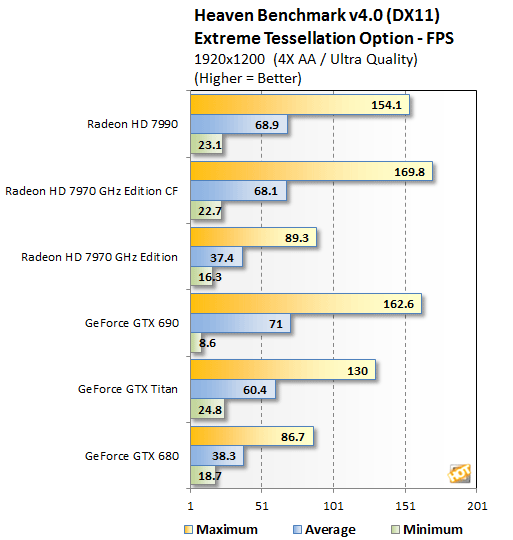

The new Radeon HD 7990 performed just as expected in the Unigine Heaven Benchmark. With a pair of Tahiti GPUs and 6GB of frame buffer memory on board (3GB per GPU), the HD 7990 is essentially a Radeon HD 7970 CrossFire configuration with slightly lower GPU clocks. As such, the card performs right in line with the dual-card Radeon HD 7970 configuration, which slightly trailed the GeForce GTX 690.
|
 Futuremark 3DMark Fire Strike Futuremark 3DMark Fire Strike | Fire Strike has two benchmark modes: Normal mode runs in 1920x1080, while Extreme mode targets 2560x1440. GPU target frame buffer utilization for normal mode is 1GB and the benchmark uses tessellation, ambient occlusion, volume illumination, and a medium-quality depth of field filter. The more taxing Extreme mode targets 1.5GB of frame buffer memory and increases detail levels across the board. Extreme mode is explicitly designed for CrossFire / SLI systems. GT 1 focuses on geometry and illumination, with over 100 shadow casting spot lights, 140 non-shadow casting point lights, and 3.9 million vertices calculated for tessellation per frame. Only 80 million pixels are processed per frame. GT2 emphasizes particles and GPU simulations. Tessellation volume is reduced to 2.6 million vertices, but the number of pixels processed per frame rises to 170 million. |
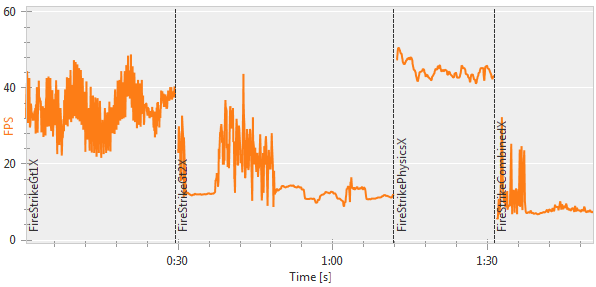
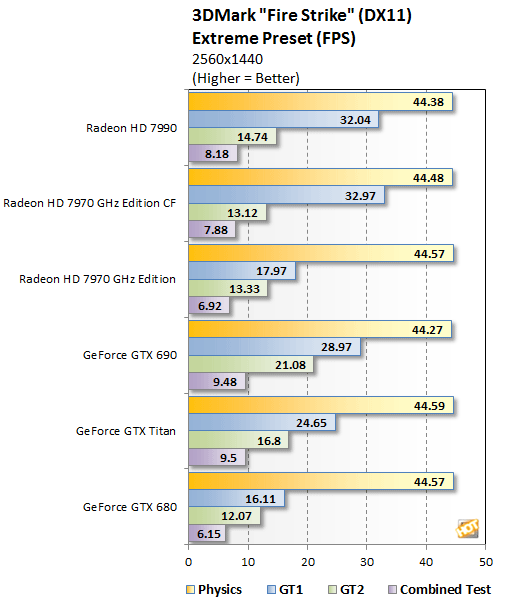
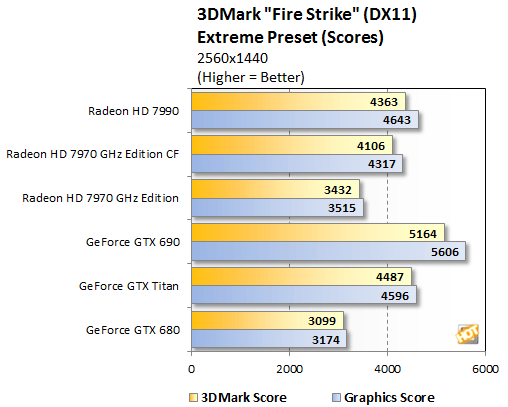
We're posting these 3DMark Fire Strike scores to show you how the Radeon HD 7990 performed in our test right, but there is a BIG caveat to mention. If you look closely at the individual test results, you'll notice that the Radeon HD 7990's performance did not scale properly in Graphics Test 2 (GT2). As such, the card's overall score is dragged way down from its expected level. AMD's internal data suggests the Radeon HD 7990 should score about 5854 points in the Fire Strike Extreme Test, with a GPU score of 6287. The drivers we were provided with the card, however, did not scale properly. And we confirmed with another publication that they had issues with this test as well. Without properly scaling, the Radeon HD 7990 performs about on part with a GTX Titan here, but trailed the GTX 690.
This issue should be resolved with a future driver update.
|
 Alien vs. Predator | The Alien vs. Predator benchmark makes use of the advanced Tessellation, screen space ambient occlusion, and high-quality shadow features available with DirectX 11. In addition to enabling all of the aforementioned DirectX 11-related features offered by this benchmark, we also switched on 4X anti-aliasing along with 16X anisotropic filtering to more heavily tax the graphics cards being tested. |
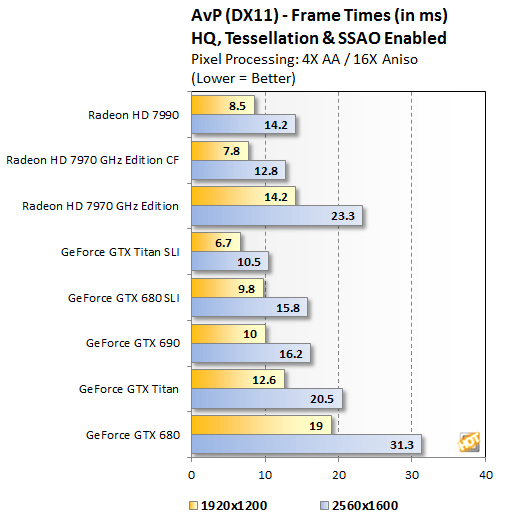

The Radeon HD 7990 put up some impressive FPS scores in the Alien vs. Predator benchmark. At both resolutions, the Radeon HD 7990 was the fastest single card of the group, besting the GTX Titan and GTX 690. A pair of GeForce GTX Titans running in SLI mode, however, is able to overtake the Radeon HD 7990--which is to be expected, since a pair of GTX Titans will cost twice as much.
1920x1200 - Click For An Enlarged View
1920x1200 - Click For An Enlarged View
Frame pacing, however, seems to be an issue in this game. We just recently (as in a couple of days ago), got our hands on the necessary hardware and software to employ NVIDIA's FCAT (Frame Capture Analysis Tool). We're still learning the ins and outs and getting comfortable with the setup, but have some initial results with the Radeon HD 7990 and a GeForce GTX 690 to show to you here.
If you're unfamiliar with FCAT, frame times, frame pacing, etc., we should explain what you're seeing in the two plots directly above. The top graph shows the actual times a frame (or part of a frame) would spend on-screen, with V-Sync disabled and the graphics cards connected to a 60Hz screen. The DVI output from our test system is split into two feeds, with one routed to a 30" LCD for testing and the other to a second rig outfitted with a DVI capture card and high-speed storage array. The FCAT software is used to mark individual game frames with a specific color and when those frames (or parts of the frames) are output to the screen, the capture card grabs them in real-time and at full resolution (up to 2560x1440) and then the FCAT analysis tools can count the frames and determine how long they spent on screen and how much of the frame was displayed. Dropped frames are counted as well as "runt" frames, which are tiny slivers of a frame that may be imperceptible to the untrained eye.
Thanks to the hard work and insight of some of our compatriots in the on-line tech press, CrossFire multi-GPU configurations are known to have frame pacing issues in a number of games currently. AMD is working on a fix, but for now, the issues persist and should be mentioned.
What the top plot tells you is that with the Radeon HD 7990, some frames are on-screen for upwards of 17-18ms, while others are barely displayed at all. The resulting jaggedness of the plot shows that although the Radeon HD 7990 is actually rendering the frames (the FPS count in the top graphs is accurate--the card is actually doing the work to render the frames), they are not being output to the screen properly, and may not actually benefitting gamers. The second plot shows that although the GeForce GTX 690 put up a lower average frame rate (99.9 FPS vs. 117 FPS), its minimum framerate was higher for much longer that the Radeon HD 7990, which is perceived as smoother, more fluid animation with less stutter.
|
 Metro 2033 Metro 2033 |
Metro 2033 is your basic post-apocalyptic first person shooter game with a few rather unconventional twists. Unlike most FPS titles, there is no health meter to measure your level of ailment; rather, you’re left to deal with life, or lack thereof, more akin to the real world with blood spatter on your visor and your heart rate and respiration level as indicators. The game is loosely based on a novel by Russian Author Dmitry Glukhovsky. Metro 2003 boasts some of the best 3D visuals on the PC platform and includes a DX11 rendering mode that makes use of advanced depth of field effects and character model tessellation for increased realism. This title also supports NVIDIA PhysX technology for impressive in-game physics effects. We tested the game at resolutions of 1920x1200 and 2560x1600 with adaptive anti-aliasing and in-game image quality options set to their High Quality mode, with DOF effects disabled.
|
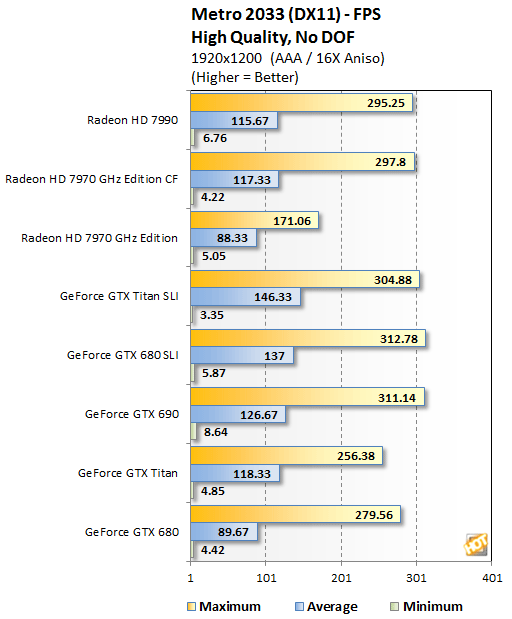
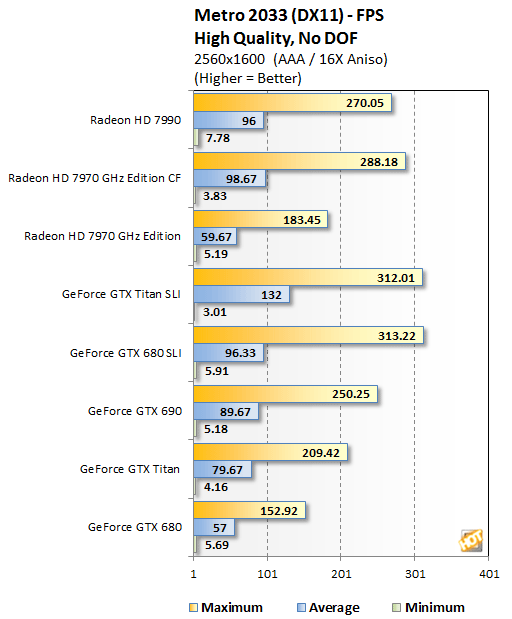
The Radeon HD 7990 and GeForce GTX 690 competed favorably in the Metro 2033 benchmark. The GeForce GTX 690 put up a better score at the lower resolution, but the Radeon HD 7990 came roaring back and took the lead with the resolution was increased to 2560x1600. As expected, the Radeon HD 7990 once again performed about on par with the Radeon HD 7970 CrossFire configuration.
1920x1200 - Click For An Enlarged View
1920x1200 - Click For An Enlarged View
Frame times are much less of an issue in this game engine, versus Alien vs. Predator on the previous page. There are some peaks and valleys with both the Radeon HD 7990 and GeForce GTX 690, which will always be the case, but generally speaking frame pacing isn't an issue here. The GeForce GTX 690, however, did spend more time with a higher minimum frame rate, but the frame rate is so high most of the time that it's a non-issue.
We spent a little time overclocking the Radeon HD 7990 to see what kind of additional frequency headroom it had left under its hood. For these tests, we used the frequency sliders available right in AMD's Catalyst Control center on the Overdrive tab.
Unfortunately, those sliders only allowed the GPU and Memory frequencies to be increased by 100MHz and 75MHz, respectively, which was no trouble from the Radeon HD 7990 at all.
|
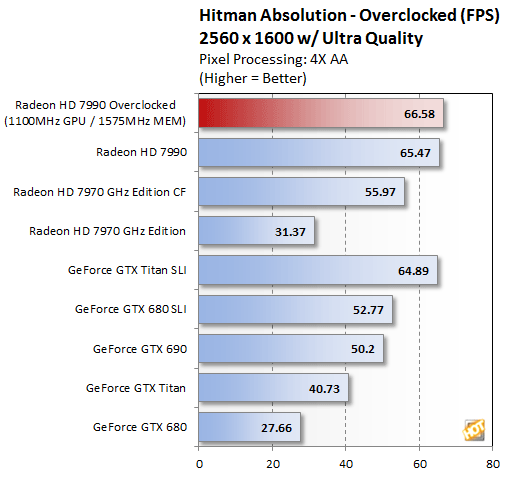
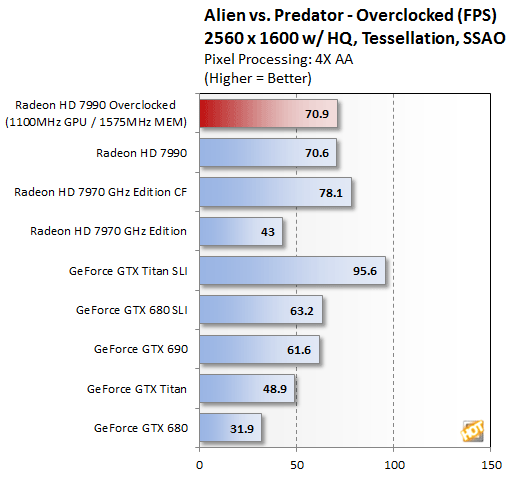
With the sliders maxed out one the Overdrive tab, the Radeon HD 7990 ran with a 1100MHz GPU clock and 1575MHz (6.3Gbps effective) memory clock, up from the default 1000MHz and 1500MHz.
While we had the card overclocked, we re-ran a couple of tests and saw only marginal improvements in performance. We're sure there's more headroom left with the card, however, which may be tapped using a third-party overclocking tool that allows for higher frequencies than Overdrive.
AMD sent over a prototype driver late in our review process, which was engineered to help alleviate some of the frame latency / frame pacing issues currently affecting CrossFire configurations. We didn’t have time to test the driver before the embargo was due to lift, but did spend some time experimenting with them yesterday.
We re-tested three games with the prototype driver to see if they had any effect on frame rates and frame latency, and compared them to the 13.5 beta 2 driver AMD recommended for performance testing. Before looking at the results, we should note that this prototype driver is built around an older base, and does not include some performance optimizations for recently released titles.
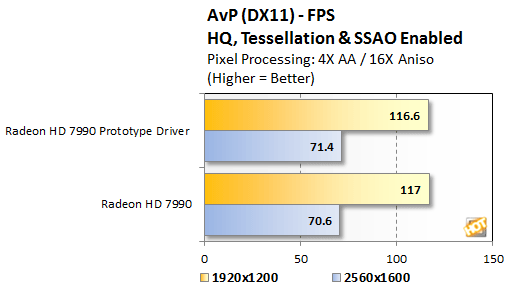
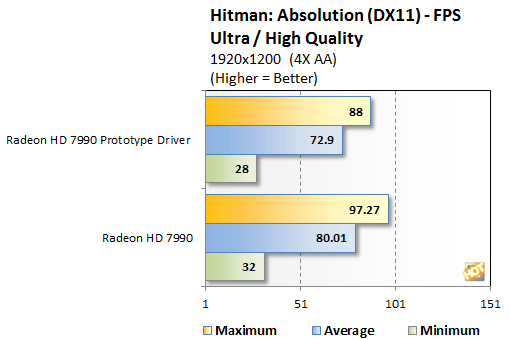
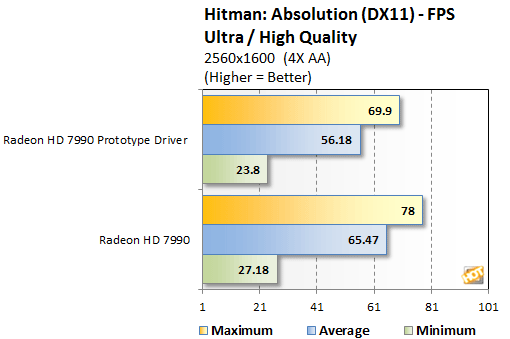
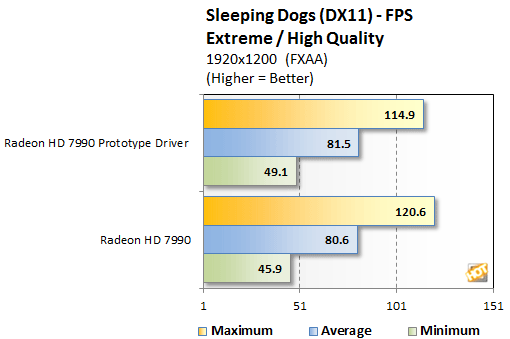
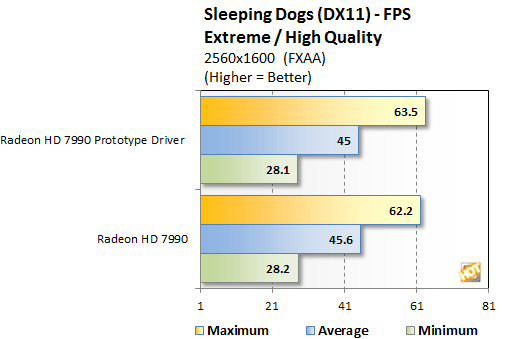
As you can see in these AvP, Sleeping Dog, and Hitman tests, frame rate performance is essentially unaffected by the prototype driver in two of the three games. The Radeon HD 7990 put up similar frame rates in AvP and Sleeping Dogs, but its performance dropped quite a bit in Hitman. We’re not sure if that’s a result of the frame pacing fixes or optimizations missing from the driver, but it’s probably the latter as you’ll see in a moment...
1920x1200 - Click For An Enlarged View
1920x1200 - Click For An Enlarged View
1920x1200 - Click For An Enlarged View
The three games we tested each behaved differently with the prototype driver. AvP showed some serious improvement in the beginning of the run, but got wonky again by the end. Hitman Absolution showed very little change, but frame pacing improved dramatically in Sleeping Dogs. The Sleeping Dogs result is an interesting case, because it shows that the frame latency issues can be addressed, without negatively impacting frame rates.
Although posting this video on-line is somewhat pointless because its resolution is scaled and its framerate is much lower than the original, we wanted to show you something very cool we’re able to do with the FCAT test system. What you see here is a side by side comparison of the actual video captures from Sleeping Dogs, with the Radeon HD 7990 using the stock beta driver (left) and the prototype driver (right). The video on the right was flipped horizontally and both were cropped so that they could be stitched together for direct comparisons.
In full resolution, full frame rate comparisons, the prototype driver is clearly producing smoother animation. We even did a couple of “blind taste tests” with non-techies and both selected the video on the right when we asked which was smoother. We just have to figure out good way to present these videos to you on-line in a way that’s representative of the original captures.
Performance Summary: There are a number of points related to the Radeon HD 7990’s performance we should discuss in this summary—frame rates, frame latency, power consumption, and noise. As the results on the preceding pages have shown, the Radeon HD 7990 puts up some impressive frame rates, outpacing the similarly priced GeForce GTX 690 and GTX Titan more often than not. Those frames, however, are not always delivered to the screen in a consistent, fluid fashion, which can result in stuttering or interruption of motion that can detract from the overall experience. The card is rendering the frames, but they’re not being sent out to the display at regular intervals. Some frames are displayed correctly, while others are dropped or only displayed for a few scan lines.
These frame latency issue are a shortcoming of AMD’s current CrossFire implementation, and the company is currently working on a fix. We actually received a prototype driver yesterday (which unfortunately came in too late to test) that reportedly addresses some of the issues, but they won’t be fully optimized and released to the public until sometime this summer. From talking with AMD (and NVIDIA), we believe AMD is going to be able to resolve the frame latency issues with CrossFire setups, but it’s unclear at what cost. Performance may ultimately be impacted, but we won’t know for sure until the drivers drop in a few months.
Power consumption under load was relatively high for the Radeon HD 7990, but we were expecting that to be the case considering the card is packing 8.6B transistors and 6GB of memory. At this point, it's clear that NVIDIA has the more power efficient GPUs in this generation, and nothing is going to change that fact. Despite the card’s relatively high power consumption though, noise is a non-issue. AMD has done an excellent job with the cooling solution on the Radeon HD 7990, plain and simple.
The AMD Radeon HD 7990
AMD reports that the Radeon HD 7990 will be available at e-tail in roughly two weeks for $999, and that price includes eight games as part of the “Never Settle Reloaded” bundle. The games include BioShock Infinite, Tomb Raider, Crysis 3, Far Cry 3, Far Cry 3: Blood Dragon, Hitman Absolution, Sleeping Dogs and Deus Ex Human Revolution. We’re told the games will be included directly in the Radeon HD 7990’s product box in any region that the bundle is available. That’s a lot of coin for a graphics card, but it is right in line with NVIDIA’s competing offerings, which don’t include nearly as many triple-AAA games.
On some levels we think the Radeon HD 7990 is one of the most impressive products ever to come out of AMD. There are obviously some kinks that need to be worked out and the card will always be limited by its software support; the fact that we saw performance scaling issues with 3DMark Fire Strike and Batman proves that point. But that is the case with all multi-GPU solutions, though, AMD’s track record isn’t as good as NVIDIA’s in that regard. With that said, the Radeon HD 7990 is immensely powerful and it runs surprisingly cool and quiet, considering its performance.
Here’s hoping AMD squashes the frame pacing issues currently affecting CrossFire configurations and keeps the driver updates flowing. It would be a shame for AMD not to exploit this card to its fullest potential. The AMD Radeon HD 7990 is a beast.

|
|
FROM : http://hothardware.com
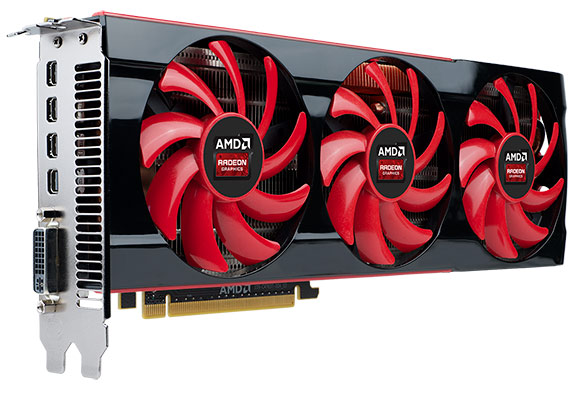

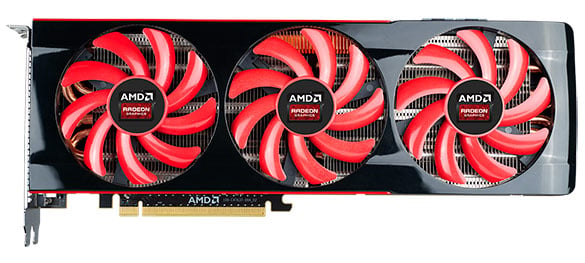
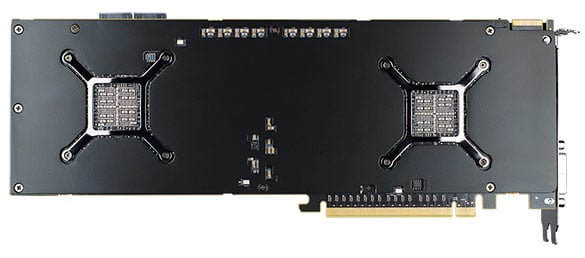
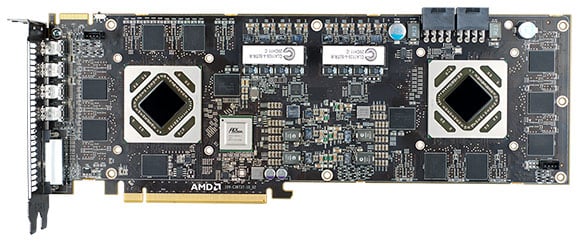
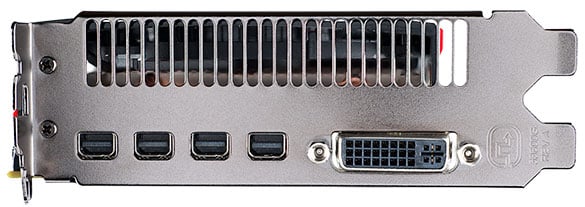
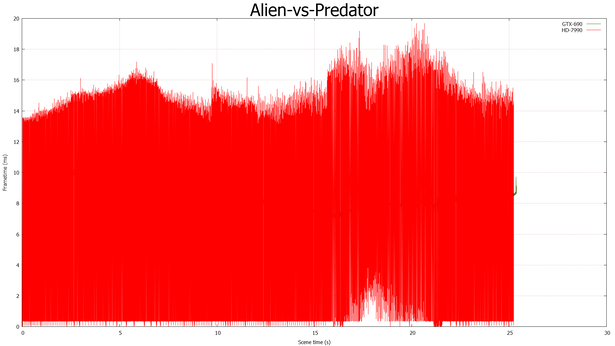
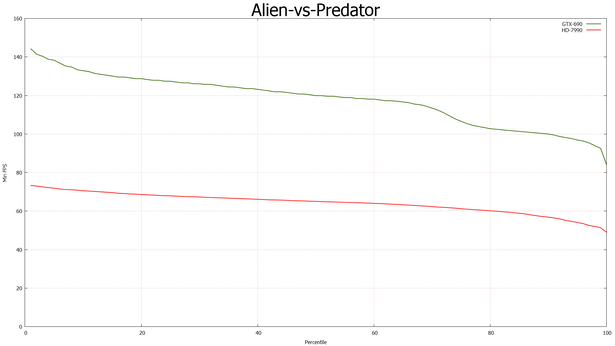
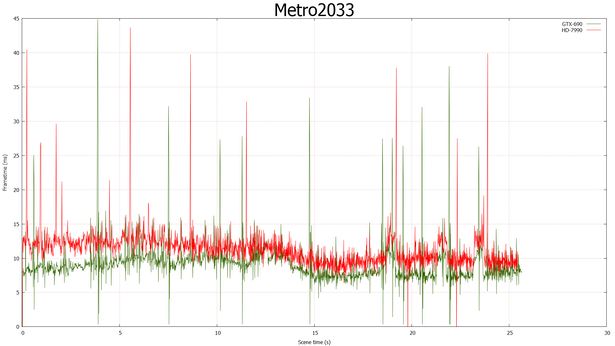
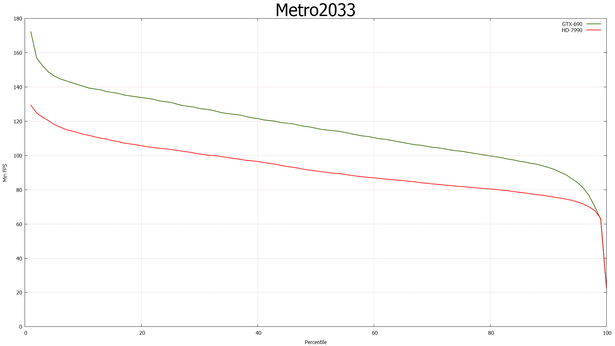
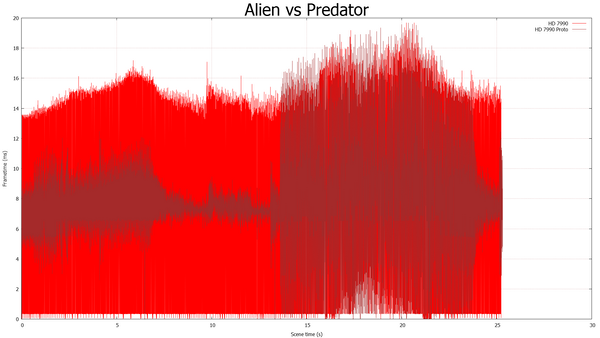
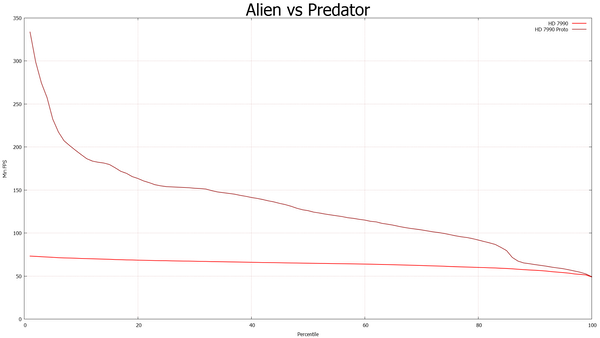
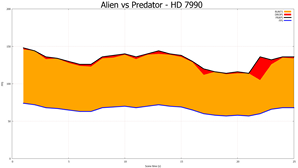
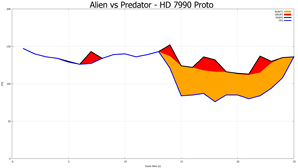
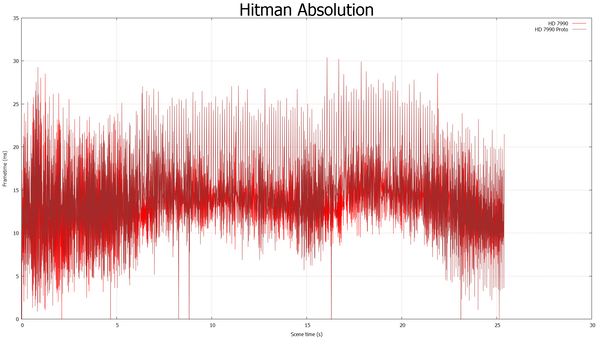
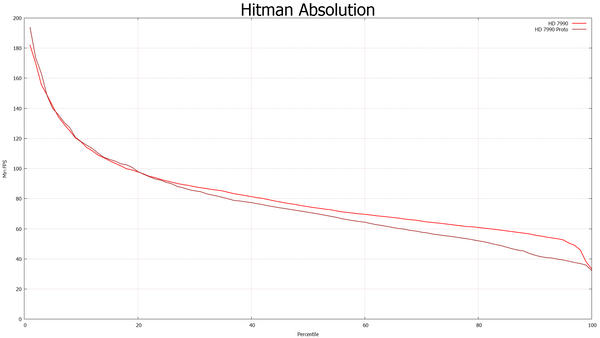
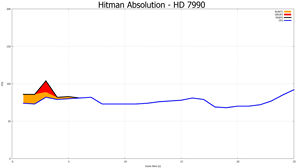
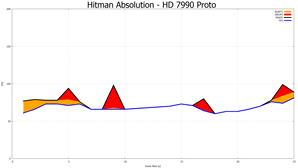
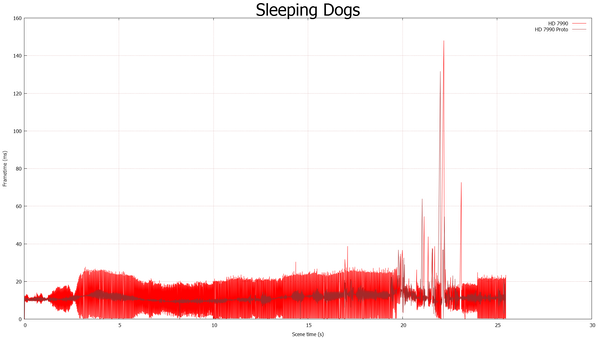
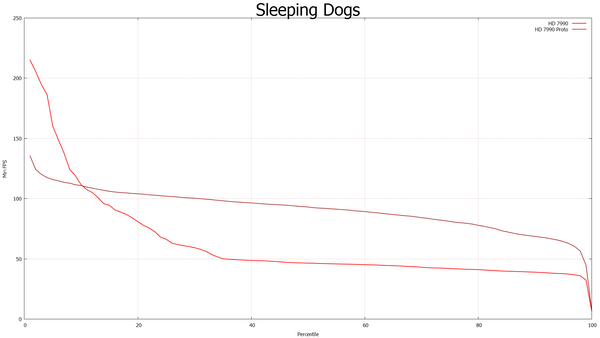

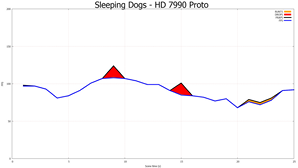


Tidak ada komentar:
Posting Komentar